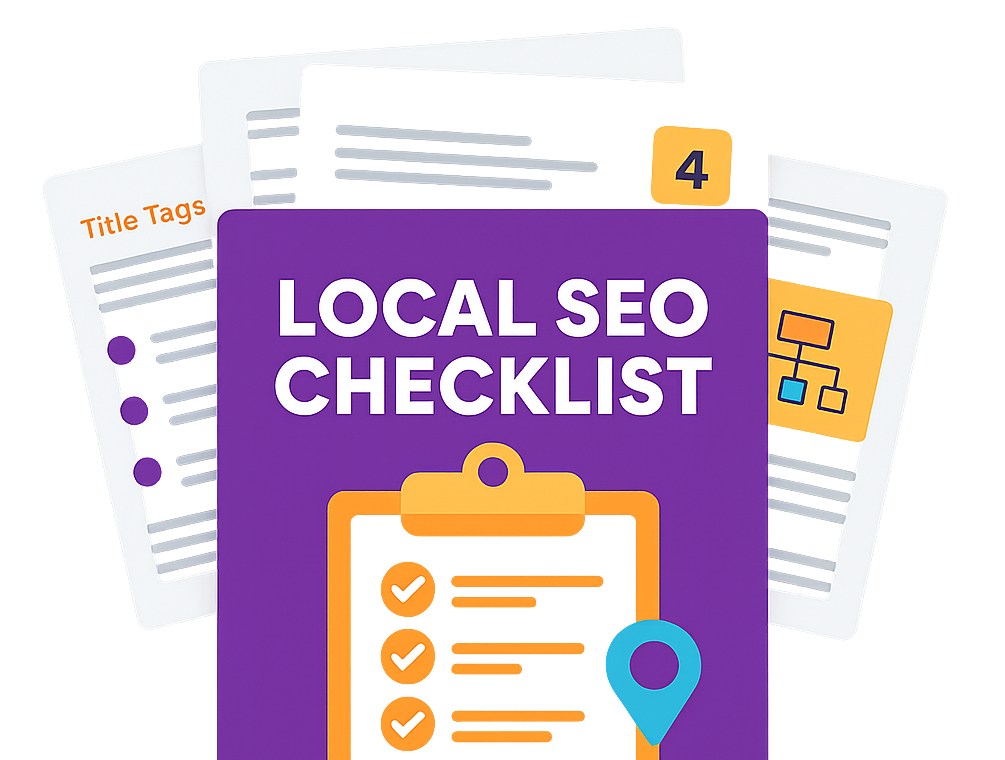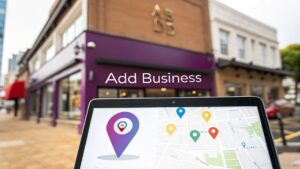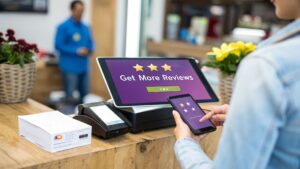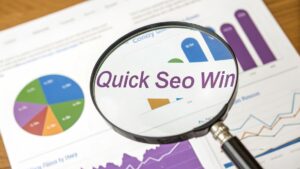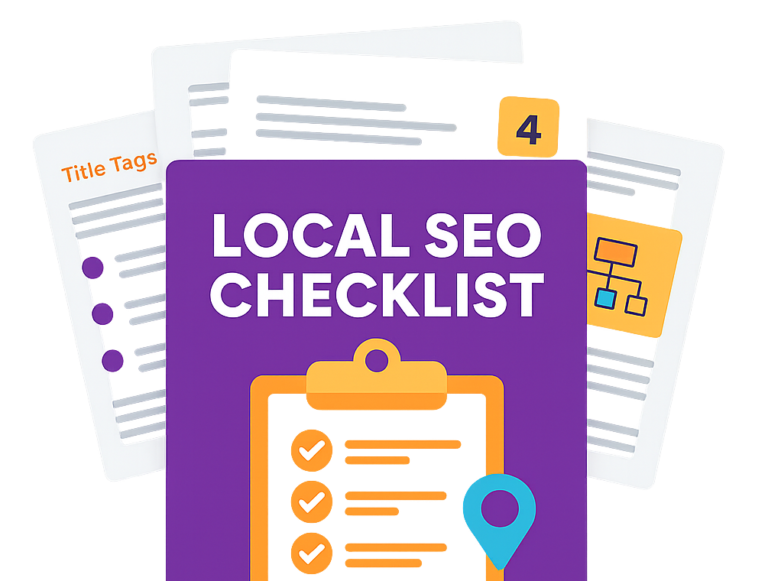Thriving as a small business in today's digital marketplace means being visible where your customers are searching: online. Yet, competing with larger corporations for top search engine spots can seem daunting. The good news is that effective search engine optimisation (SEO) isn't just for big brands with huge budgets. With the right strategy, any small enterprise can significantly boost its online presence, attract more local customers, and achieve sustainable growth.
This guide is designed to cut through the noise. We will provide a clear, step-by-step roadmap with eight essential and actionable small business SEO tips, created specifically for businesses in the UK. Forget vague theories; we are focusing on practical tactics you can implement immediately.
You will learn how to master local search to attract nearby customers in areas like Cambridgeshire, conduct strategic keyword research that gets results, and create high-quality content that engages and converts. We will also cover optimising your website's technical performance and fully leveraging your Google Business Profile. These proven methods will help you climb the search rankings, increase your online visibility, and turn valuable clicks into loyal customers. Let's begin your journey to dominating local search results.
1. Master Your Neighbourhood: Optimise for Local SEO
For any small business with a physical storefront or a defined service area, local SEO is not just a good idea; it's the foundation of your digital strategy. This approach focuses on optimising your online presence to capture customers searching for products or services in your immediate vicinity. When a potential customer in Cambridge searches for "fresh sourdough near me" or a family in Bristol looks for a "dentist in Clifton", local SEO is what ensures your business appears prominently in those crucial, high-intent search results.
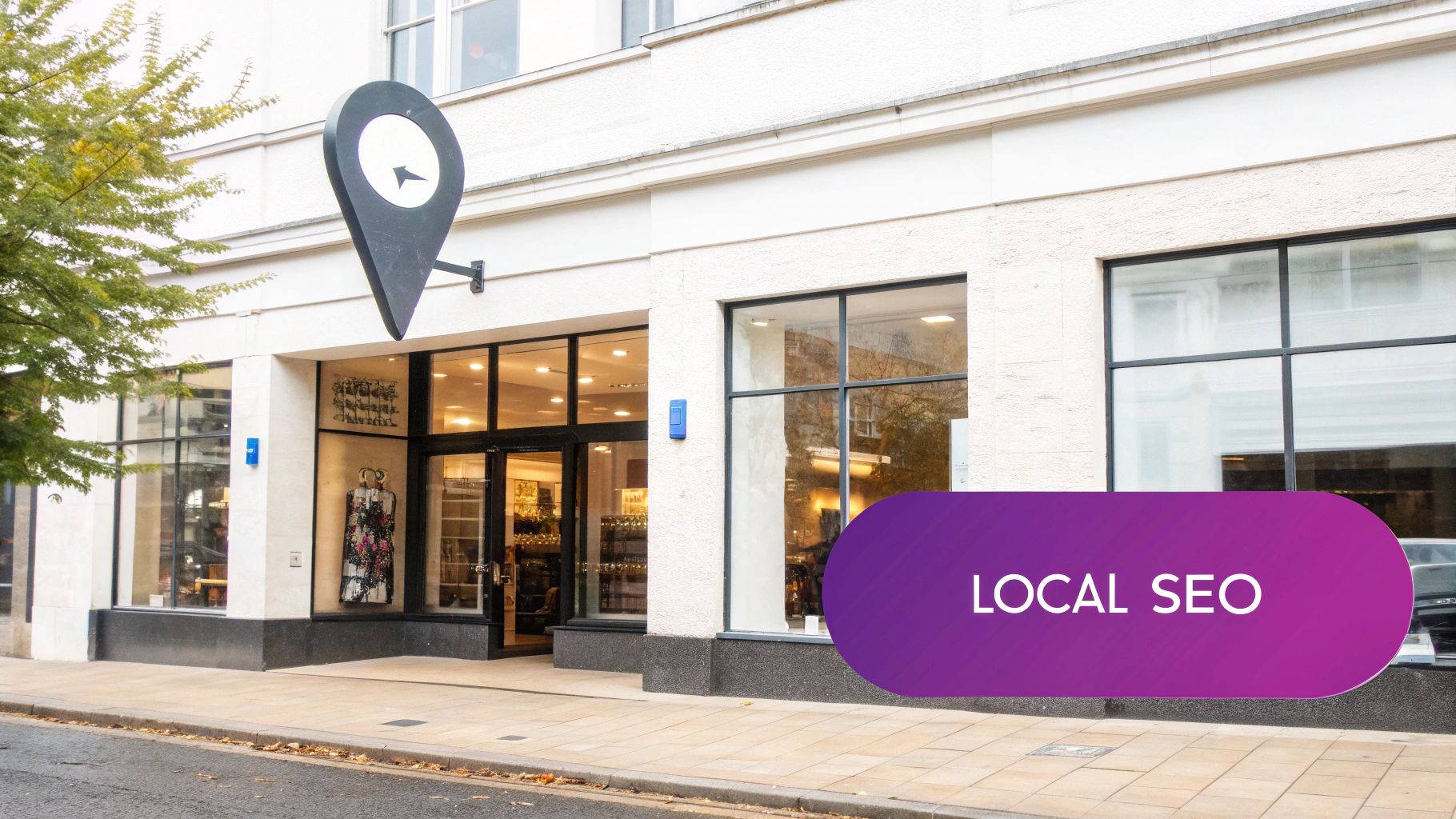
The goal is to dominate Google's "Local Pack" – the map and three business listings that appear at the top of search results for local queries. This prime digital real estate often receives the majority of clicks, driving significant foot traffic and phone calls. Mastering this is one of the most impactful small business SEO tips for achieving tangible, local growth.
How to Implement Local SEO
Getting started with local SEO involves a focused, multi-faceted approach. Your primary goal is to send clear, consistent signals to Google about who you are, what you do, and where you operate.
- Claim Your Google Business Profile (GBP): This is non-negotiable. Immediately claim and meticulously verify your free GBP listing. Fill out every single section, including services, opening hours, photos, and attributes.
- Maintain NAP Consistency: Your Name, Address, and Phone number (NAP) must be identical everywhere online. Check your website, social media profiles, and other online directories for any discrepancies and correct them.
- Cultivate Customer Reviews: Actively and consistently encourage satisfied customers to leave reviews on Google. Positive reviews build trust and are a significant ranking factor for the Local Pack.
- Localise Your Website Content: Create content that specifically targets your service areas. Use location-based keywords naturally in your page titles, headings, and body text (e.g., "emergency plumber in Norwich").
- Utilise Local Business Schema: Implement local business schema markup on your website. This structured data helps search engines understand crucial details about your business, such as your location and services, improving how you're represented in search results. For a deeper dive into the tools that can help streamline this process, you can explore the best local SEO tools on bare-digital.com.
2. Conduct Strategic Keyword Research
Keyword research is the process of identifying the specific phrases and questions your target audience uses when searching on Google. For a small business, this isn't about chasing broad, highly competitive terms. Instead, it’s a strategic exercise in finding niche, high-intent keywords that you can realistically rank for, driving relevant traffic that is more likely to convert into actual customers.

This foundational practice informs every other aspect of your SEO, from website content to blog posts and local listings. By understanding the precise language of your potential customers, you can create content that directly answers their needs. Mastering this is one of the most crucial small business SEO tips because it ensures your limited resources are focused on attracting the right audience. For instance, a home renovation contractor should target "kitchen remodel cost Cambridge" rather than the impossibly broad "home improvement".
How to Implement Keyword Research
Effective keyword research for a small business means focusing on specificity and user intent. The goal is to uncover opportunities your larger competitors might overlook.
- Focus on Long-Tail Keywords: These are longer, more specific phrases of three or more words. They have lower search volume but much higher conversion rates. A local yoga studio should target "beginner yoga classes central Cambridge" instead of just "yoga".
- Prioritise Commercial Intent: Look for keywords that signal a user is ready to buy or enquire, such as phrases including "quote," "near me," "cost," or "for hire." These terms attract users at the bottom of the sales funnel.
- Incorporate Location Modifiers: Just as with local SEO, adding your town, city, or county to your keywords (e.g., "emergency electrician in Cambridgeshire") is vital for attracting a local customer base.
- Analyse Competitor Keywords: Use free tools to see what keywords your direct competitors are ranking for. This can reveal valuable opportunities and content gaps you can fill.
- Create Keyword Clusters: Group related keywords together around a central topic. This helps you plan and create comprehensive content that covers a subject in depth, establishing your authority with search engines.
3. Create High-Quality, Relevant Content
At the heart of any successful SEO strategy is high-quality content. For a small business, this means moving beyond simple sales copy and producing valuable, informative, and engaging material that directly addresses your customers' questions and problems. This approach, popularised by experts like Marcus Sheridan with his "They Ask, You Answer" philosophy, positions your business as a trusted authority, not just a seller. When you consistently provide answers, you build trust and attract organic traffic from users actively seeking your expertise.

The goal is to create content that serves a genuine purpose for your audience, which in turn sends powerful positive signals to search engines like Google. For instance, an HVAC company in Cambridge that creates a detailed guide on "how to improve boiler efficiency in winter" is far more likely to rank for related searches than one with only a basic services page. This is one of the most fundamental small business SEO tips because great content is the fuel for every other SEO activity, from link building to social sharing.
How to Implement Content Creation
Developing a content strategy involves identifying your customers' pain points and creating resources that solve them. Your primary objective is to become the go-to source of information in your niche.
- Answer Customer Questions: Brainstorm every question you receive from customers, no matter how simple. Turn each question into a detailed blog post, FAQ page, or video. This directly targets the long-tail keywords your audience is using.
- Focus on Local Relevance: Weave local references into your content. A financial advisor in Peterborough could publish an analysis of the local property market, or a restaurant could share stories about its Cambridgeshire-based suppliers.
- Mix Content Formats: Don't limit yourself to just blog posts. Use a variety of formats to keep your audience engaged, such as how-to guides, customer case studies, infographics, and short, informative videos.
- Optimise for Topics, Not Just Keywords: While keywords are important, think in terms of topics. Cover a subject comprehensively to demonstrate your expertise. If you're a plumber, create a pillar page on "central heating maintenance" and link out to smaller articles on specific issues.
- Refresh and Update Old Content: SEO is not a "set it and forget it" task. Regularly review your older posts for outdated information, broken links, or opportunities to add new insights. Updating content can give it a significant ranking boost.
4. Optimise On-Page SEO Elements
On-page SEO is the practice of optimising the individual pages of your website to improve their search engine rankings and attract more relevant traffic. It involves refining the elements that are directly within your control, such as your content and HTML source code. For a small business, getting the fundamentals of on-page optimisation right is a powerful, low-cost way to signal to Google exactly what each page is about, making it easier for search engines to match your content with user queries.
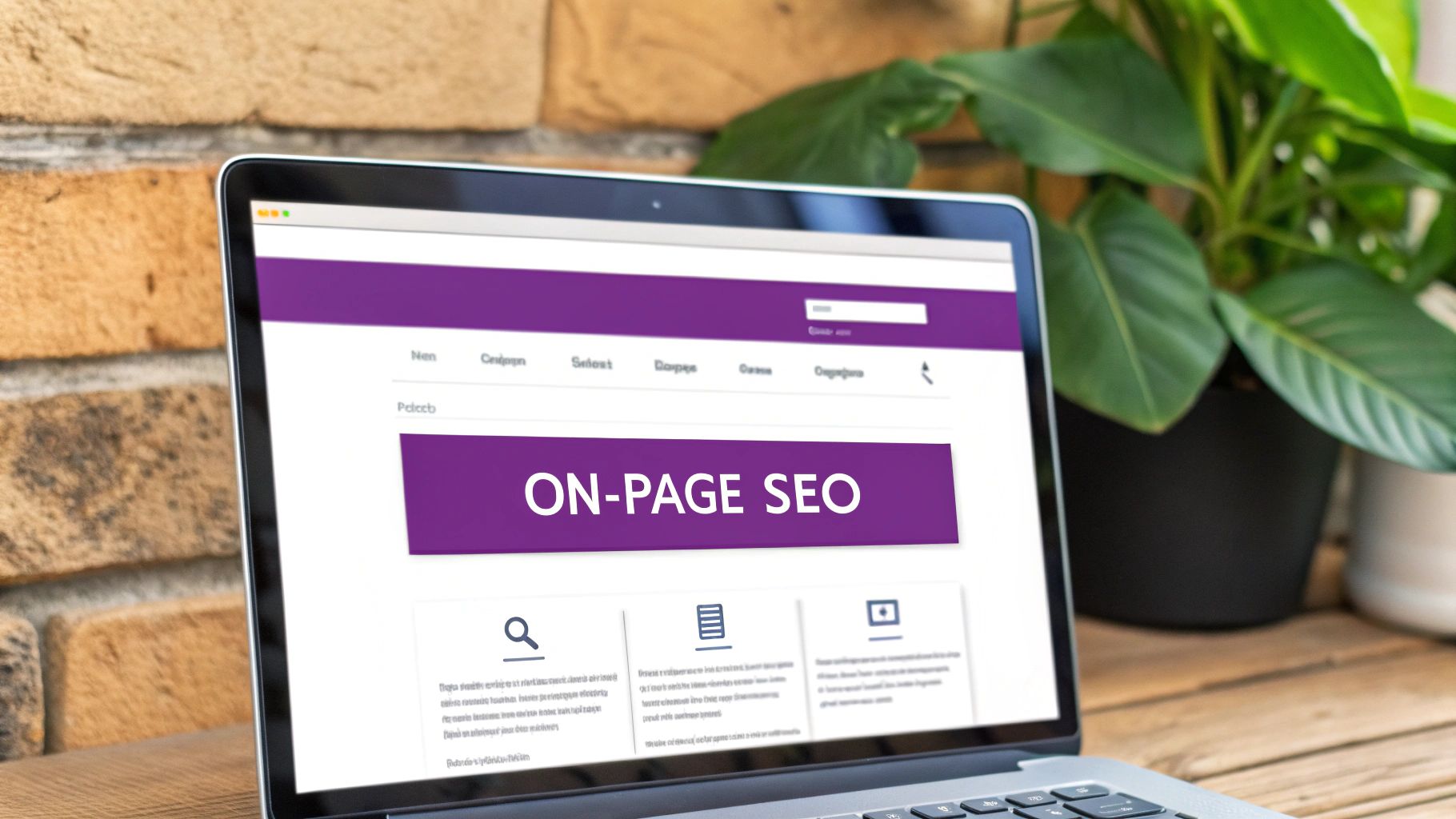
Unlike off-page SEO, which focuses on external signals like backlinks, on-page SEO is about making your own website as clear, user-friendly, and search-engine-friendly as possible. This is one of the most crucial small business SEO tips because it empowers you to directly influence your rankings. A well-optimised page, for example, helps a local law firm clearly communicate its specialism and location, such as "family law solicitor in Cambridge", directly within its key on-page elements.
How to Implement On-Page SEO
A methodical approach to on-page elements ensures every page on your site is working hard to bring in the right audience. These small adjustments can lead to significant improvements in visibility and traffic.
- Refine Your Title Tags: Your title tag is the most important on-page element. Keep it under 60 characters and include your primary keyword, ideally near the beginning. For instance, a title like "Handmade Leather Wallets | The Cambridge Satchel Co." is clear and effective.
- Write Compelling Meta Descriptions: While not a direct ranking factor, a good meta description (under 160 characters) acts as an advert for your page in search results, encouraging clicks. Make it engaging and include a call to action.
- Structure Content with Headings: Use a single, unique H1 tag for your main page title. Use H2s and H3s to break up content into logical, readable sections, incorporating related keywords where it feels natural.
- Create Clean, Descriptive URLs: Your page URL should be simple and easy to understand. Instead of
/page-id=123, use a structure like/services/commercial-window-cleaning. - Optimise Your Images: Compress images to ensure fast loading times and always use descriptive alt text. Alt text helps search engines understand the image content and improves accessibility for visually impaired users.
- Use Internal Linking: Link to other relevant pages on your own website within your content. This helps distribute link equity and guides both users and search engines to other valuable information, keeping them on your site for longer.
5. Build Quality Backlinks
Think of the internet as a vast network of interconnected pages. Backlinks are the hyperlinks from other websites pointing to yours, acting as votes of confidence or referrals. For search engines like Google, a high-quality backlink from a reputable, relevant site signals that your content is valuable and trustworthy, which can significantly boost your search engine rankings. It's a cornerstone of any effective SEO strategy, telling Google that your business is a recognised authority in its field.
This process, known as link building, is not about acquiring as many links as possible. For small businesses, the focus must be on quality and relevance. A single link from the local Chamber of Commerce website is far more valuable than dozens of links from irrelevant, low-quality blogs. Pursuing relevant links is one of the most powerful small business SEO tips for building long-term authority and outranking competitors.
How to Build Quality Backlinks
A strategic, relationship-focused approach is key to earning valuable backlinks. The goal is to create connections and provide value that makes other organisations want to link to your website.
- Focus on Local Relevance: Start in your own backyard. Get your business listed in local directories, such as the Chamber of Commerce or local business associations. Sponsor a local charity event or a youth sports team in exchange for a link from their website.
- Create "Linkable Assets": Develop content that others will naturally want to share and reference. This could be a comprehensive guide to a local problem, an original research report for your industry, a helpful checklist, or an insightful case study.
- Leverage Existing Relationships: Think about the suppliers, vendors, and partners you already work with. Offer to write a testimonial for their website in exchange for a link back to yours. This is a simple and mutually beneficial way to gain a relevant backlink.
- Engage with Your Industry: Write guest posts for respected industry blogs or local news sites. For example, a restaurant owner could contribute an article to a local food blog, or a software consultant could get listed as a preferred partner by an industry association.
- Analyse Your Competitors: Use SEO tools to see who is linking to your competitors. This can reveal opportunities you might have missed, such as industry directories or publications that you could also approach. For a comprehensive overview of tactics, you can learn more about how to build backlinks on bare-digital.com.
6. Optimise Website Technical Performance
Technical SEO is the engine under the bonnet of your website. It ensures search engines like Google can efficiently find, crawl, index, and understand your content without hitting any roadblocks. While content is king, technical optimisation ensures the king can actually rule his kingdom. For a small business, a technically sound website can be a huge competitive advantage, providing a seamless user experience that bigger, clunkier sites might fail to deliver.
This is all about the foundational health of your site. Issues like slow page loading times, a confusing site structure, or broken links can severely damage your rankings and frustrate potential customers, causing them to leave before they even see what you offer. Focusing on these elements is one of the most crucial small business SEO tips because it directly impacts both search engine bots and human visitors.
How to Implement Technical SEO
Improving your site's technical performance involves a series of checks and optimisations to ensure it's fast, secure, and easy for search engines to navigate.
- Boost Your Site Speed: Use tools like Google's PageSpeed Insights to diagnose speed issues. Simple fixes often include compressing and optimising all images, enabling browser caching, and minimising code to reduce loading times.
- Prioritise Mobile-First Design: Your website must perform flawlessly on mobile devices. A responsive design that adapts to any screen size is essential, as Google predominantly uses the mobile version of a site for indexing and ranking.
- Maintain a Clean Site Structure: Ensure your website is logically organised with a clear hierarchy. This helps both users and search engines navigate your pages. A simple structure is often the most effective.
- Conduct Regular Audits: Routinely check for technical problems like broken links (404 errors) and server issues. Fixing these errors improves user experience and prevents "crawl budget" from being wasted on dead-end pages.
- Create and Submit a Sitemap: An XML sitemap acts as a roadmap for search engines, listing all your important pages. Submitting this file to Google Search Console helps ensure all your content gets discovered and indexed promptly. To get started, you can follow this comprehensive technical SEO audit checklist on bare-digital.com.
7. Track and Analyse SEO Performance
Launching an SEO strategy without tracking its performance is like driving with your eyes closed. You are putting in the effort, but you have no idea if you are heading in the right direction. SEO analytics involves monitoring, measuring, and analysing your website's search performance to understand what’s working, identify areas for improvement, and make data-driven decisions that generate real business results.
This process moves beyond vanity metrics like simply being "number one" for a single keyword. Instead, it focuses on the data that truly matters: Is organic traffic increasing? Are visitors engaging with your content? Most importantly, are these efforts leading to more enquiries, sales, and revenue? For a small business, this analytical approach is one of the most crucial small business SEO tips for ensuring your investment of time and money yields a tangible return.
How to Implement SEO Performance Tracking
Effective analysis begins with setting up the right tools and defining what success looks like for your business. The goal is to create a clear feedback loop where data informs your next steps, leading to continuous improvement.
- Set Up Foundational Tools: Your first step is to install Google Analytics and verify your site with Google Search Console. These free tools are non-negotiable for understanding how users find and interact with your website.
- Define Clear KPIs: Go beyond just rankings. Identify Key Performance Indicators (KPIs) that align with your business goals, such as organic traffic growth, keyword visibility for your main services, click-through rates (CTR), and, most critically, conversion rates from organic search.
- Establish a Reporting Cadence: Create a routine for reviewing your data. A monthly performance report helps you spot trends, celebrate wins, and quickly address any issues. This ensures you are consistently optimising your strategy based on hard evidence. To build a comprehensive and effective report, you can use our guide and a monthly SEO report template on bare-digital.com.
- Track Conversion Goals: In Google Analytics, set up specific goals that match your business objectives. This could be tracking contact form submissions, phone calls, or e-commerce purchases originating from organic search.
- Monitor Local Visibility: For businesses serving a specific area, track your rankings in Google's Local Pack and on Google Maps for your most important local keywords (e.g., "accountants in Cambridge").
8. Leverage Google Business Profile Fully
Your Google Business Profile (GBP) is arguably the most powerful free tool in your local SEO arsenal. It's the dynamic digital storefront that appears in Google Search and on Google Maps, offering potential customers their first, crucial impression of your business. Fully optimising this profile is not just a box-ticking exercise; it's an active strategy to enhance visibility, build trust, and drive direct customer actions like calls, website visits, and direction requests.
For a local customer, your GBP is the most direct path to your door. Think of it as your business's comprehensive digital business card, presented by Google at the exact moment a potential customer needs you. Neglecting this profile is like leaving your physical shop front unpainted and without a sign; it's a missed opportunity that your competitors will happily seize. Making this a priority is one of the most effective small business SEO tips for immediate local impact.
How to Implement GBP Optimisation
A complete and active profile sends strong signals to Google that your business is legitimate, relevant, and engaged. The goal is to use every feature available to provide a rich, informative, and compelling snapshot of your business.
- Complete Every Section: Meticulously fill out every single field available in your GBP dashboard. This includes adding detailed service descriptions, accurate opening hours, accessibility attributes, and selecting all relevant business categories.
- Utilise Google Posts: Treat Google Posts like a social media feed for your business. Share updates, announce daily specials, promote events, or highlight new products at least once a week to keep your profile fresh and active.
- Upload High-Quality Visuals: Regularly add high-quality photos and videos of your premises, team, products, and happy customers. This visually verifies your business and helps potential customers understand what to expect.
- Manage Reviews & Q&A: Actively encourage reviews and respond to every single one, both positive and negative. Also, monitor the Questions & Answers section, proactively adding and answering common queries to control the narrative.
- Enable Messaging: Turn on the messaging feature to allow customers to contact you directly from your profile. A prompt response time is crucial here and can be the deciding factor for a potential customer choosing your business.
8 Key Small Business SEO Tips Comparison
| Strategy | Implementation Complexity | Resource Requirements | Expected Outcomes | Ideal Use Cases | Key Advantages |
|---|---|---|---|---|---|
| Optimise for Local SEO | Moderate | Moderate (tools, ongoing review management) | Higher local visibility, increased foot traffic, better conversions | Businesses with physical locations serving specific areas | Cost-effective, competitive local advantage |
| Conduct Strategic Keyword Research | Moderate to High | Moderate to High (tools, time) | Targeted traffic, better content strategy, competitive edge | Businesses needing targeted, intent-driven traffic | Understands customer language, guides content |
| Create High-Quality, Relevant Content | High | High (time, skill) | Authority building, improved rankings, long-term organic traffic | Businesses focusing on education, trust, and engagement | Builds trust, supports marketing, improves SEO |
| Optimise On-Page SEO Elements | Moderate to High | Moderate (technical skills/tools) | Improved rankings, better user experience, higher CTR | Any website needing direct content and structure SEO improvements | Immediate control, supports overall SEO strategy |
| Build Quality Backlinks | High | High (outreach, relationship building) | Increased domain authority, referral traffic, brand awareness | Businesses seeking authority and local/industry connections | Long-term SEO benefits, relationship building |
| Optimise Website Technical Performance | High | High (technical expertise, possibly dev help) | Better UX, improved rankings, higher conversions, lower bounce | Websites needing faster speeds and crawl optimisation | Competitive advantage, improved indexing |
| Track and Analyse SEO Performance | Moderate | Moderate to High (tools, analysis skills) | Data-driven decisions, optimisation insights, ROI measurement | Businesses focused on continual SEO improvement | Helps prioritise efforts, measures success |
| Leverage Google Business Profile Fully | Low to Moderate | Low to Moderate (time, active management) | Immediate local visibility, direct customer communication | Local businesses dependent on Google Search and Maps | Free tool, enhances local presence, direct engagement |
Putting Your SEO Plan into Action
Embarking on search engine optimisation can feel like a formidable task, but as we've explored, it's a journey of consistent, focused steps rather than a single giant leap. The path to higher rankings and increased organic traffic is paved with the practical, actionable strategies we've detailed. From claiming your local territory with a meticulously optimised Google Business Profile to performing strategic keyword research that uncovers what your customers are truly searching for, you now possess the blueprint for digital success.
The true power of these small business SEO tips lies not in their individual application, but in their synergy. Creating high-quality, relevant content establishes your authority, while precise on-page optimisation ensures search engines understand its value. Building a strong backlink profile acts as a vote of confidence from other websites, and a technically sound website provides the seamless user experience that both visitors and Google appreciate. Each element reinforces the others, creating a powerful, self-sustaining cycle of growth.
Your Immediate Next Steps
Don't let this newfound knowledge remain theoretical. The key to turning these insights into tangible results is immediate and consistent action. Here’s a simple plan to get started:
- Conduct a Self-Audit: Start with the basics. Review your Google Business Profile against the best practices mentioned. Is every section complete? Are your photos recent? Are you actively collecting reviews?
- Identify Low-Hanging Fruit: Pinpoint one or two areas for immediate improvement. Perhaps your page titles are generic, or your website's mobile speed is lagging. Small, quick wins can build significant momentum.
- Commit to Consistency: Schedule time each month dedicated to SEO. This could be for writing one new blog post, analysing your Google Analytics data, or seeking one new backlink opportunity. Consistency will always outperform sporadic, intense efforts.
Mastering SEO is one of the most cost-effective and sustainable ways to grow your business. It’s an investment in your brand's long-term visibility, credibility, and profitability. By taking control of your online presence, you move from passively hoping for customers to actively attracting your ideal audience, whether you're a local service provider in Cambridgeshire or an e-commerce store with national ambitions. The effort you invest today will continue to pay dividends for years, establishing a digital foundation that supports scalable, organic growth.
Feeling overwhelmed or simply want an expert to guide you? Our team at Bare Digital specialises in creating bespoke SEO strategies that drive measurable results for small businesses. Let us take the guesswork out of the equation with a complimentary SEO Health Check and a clear, transparent Activity Plan tailored to your specific goals. Visit Bare Digital to take the first step towards better visibility today.


